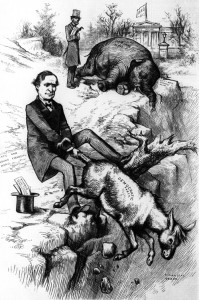Donkeys vs. Elephants?

An 1879 political cartoon by Thomas Nast in Harper’s Weekly includes an early use of the elephant and the donkey to symbolize the Republican and Democratic parties.
Credit: Library of Congress
The donkey is a popular symbol of the Democratic Party in the United States, and the elephant is a symbol of the Republican Party. Have you ever wondered why that is? Maybe you have never thought about these political symbols—perhaps you thought they were irrelephant!
The donkey and the elephant began representing the Democratic and Republican parties, respectively, in the 1800’s. The American political cartoonist Thomas Nast (1840-1902) popularized the symbols while working at the magazine Harper’s Weekly. Through political cartoons that featured a variety of animals, Nast illustrated—both literally and figuratively—that politics was a circus.
The Democratic donkey is believed to have first been used during the 1828 presidential campaign. The Democratic candidate Andrew Jackson—who went on to win the presidency that year—used the symbol on his posters, in defiance of opponents who had unflatteringly compared him to a type of donkey.
Historians believe that Nast’s 1874 cartoon “The Third Term Panic” popularized the elephant as a symbol of the Republican Party. In the cartoon, a donkey disguised as a lion chases several animals. An elephant labeled “Republican Vote” lumbers toward a pit labeled “inflation” and “chaos.” Nast said the elephant depicted the confused creature that was the Republican Party.
Nast is also known for his work during the American Civil War (1861-1865), when his political cartoons influenced public opinion in favor of the North. The donkey and the elephant are not the only American symbols associated with Nast. He is credited with creating the present-day image of Santa Claus in sketches that appeared in Harper’s Weekly in the 1860’s.
Although elephants and donkeys vary in size, color, habitat, and political leaning, they have one thing in common—they each proudly wear “I voted” stickers.


